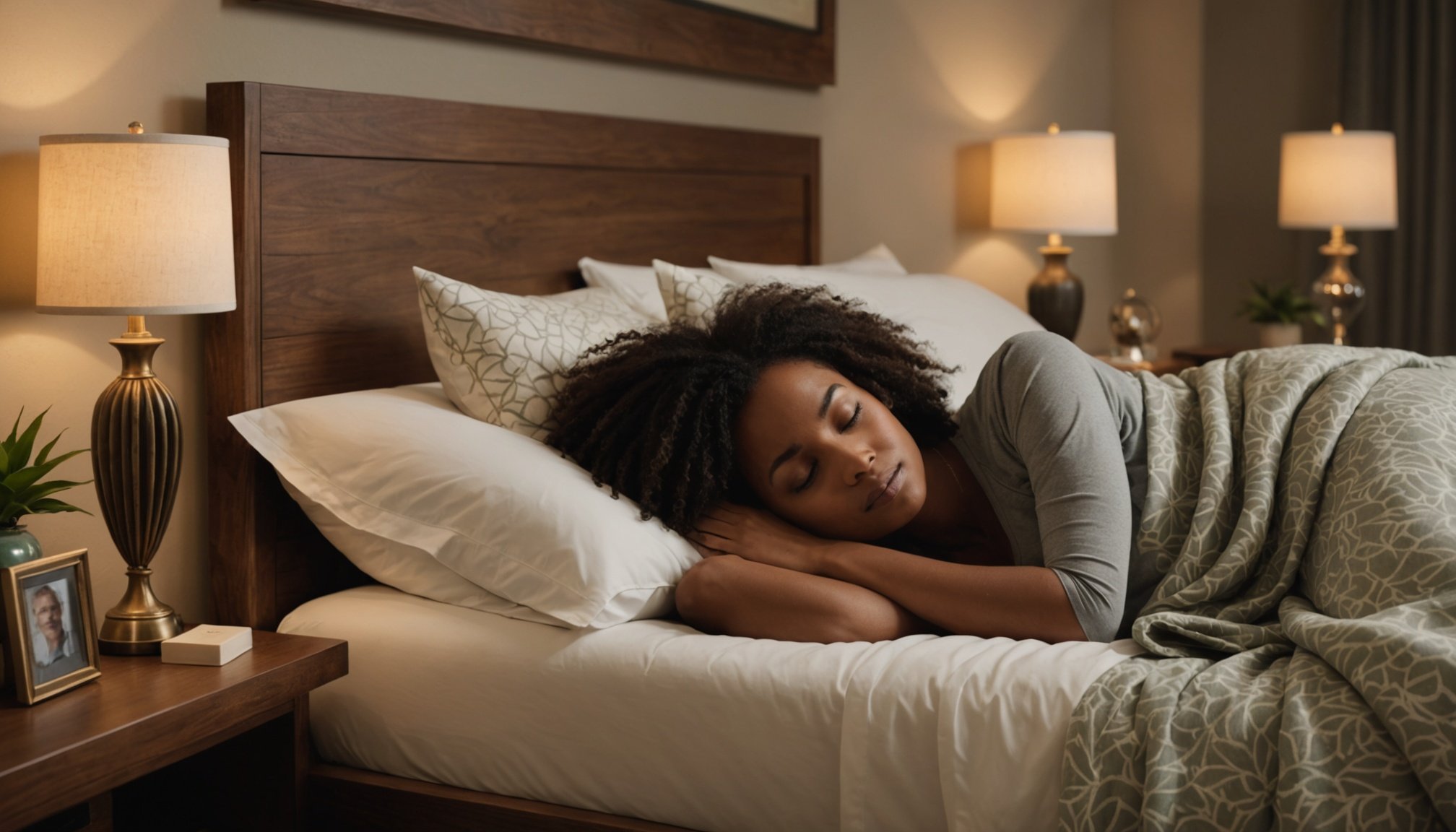The Importance of a Sleep-Conducive Environment
Creating a sleep environment that promotes restfulness is essential for achieving high sleep quality. Your surroundings have a considerable impact on your ability to fall asleep and stay asleep. The right environment can transform restless nights into peaceful slumbers by reducing distractions and promoting relaxation. This, in turn, influences how energetic and alert you feel in the mornings.
A well-thought-out calming atmosphere ensures that your bedroom remains a sanctuary for rest. Consider incorporating elements that foster a peaceful ambiance, such as soft textiles, muted colour palettes, and clutter-free spaces. These subtle inclusions can enhance the room’s tranquillity, ultimately contributing to a more rejuvenating sleeping experience.
In the same genre : Uncover the benefits of adding organic cotton to your fashion lineup: a sustainable choice for style and comfort
By intertwining these features into your nightly routine, you develop a profound connection between your environment and your sleep patterns. A properly arranged space naturally encourages more restful nights, resulting in more energetic mornings. Prioritising a sleep-conducive environment doesn’t just help in falling asleep more quickly; it also enhances the overall sleep cycle.
The benefits are clear: a harmonious sleep environment is foundational to nurturing quality sleep. By making mindful adjustments to your surroundings, you lay the groundwork for more restful nights and revitalised daytimes.
Topic to read : Ultimate guide to seamlessly organizing your makeup collection for quick and easy access
Bedroom Decor Choices
Crafting a bedroom with thoughtful decor choices can profoundly influence your sleep quality and promote a sense of tranquility. The design of your sleep space acts as a silent contributor, often impacting how restful and rejuvenated you feel each morning.
Choosing the Right Colour Schemes
Selecting the right colour schemes plays a crucial role in cultivating a calming design. Colours like soft blues, gentle greens, and muted greys can create a serene atmosphere conducive to relaxation. They’re known to lower heart rates and alleviate stress, thereby setting the stage for a peaceful slumber.
Furniture Arrangement for Serenity
The arrangement of furniture contributes significantly to the overall tranquillity of your bedroom. Aim for a layout that minimizes disruptions and maintains a smooth flow of space. This can involve positioning your bed away from direct sight lines with doors and windows, which helps reduce distractions and promotes a restful setting.
Minimalist vs. Cozy Decor Styles
When choosing between a minimalist or a cozy style, consider your personal comfort and tranquility needs. A minimalist approach emphasizes a clutter-free environment, ideal for reducing mental clutter. Conversely, cozy decor can offer warmth, employing layered textiles and soft lighting to create an inviting retreat. Finding the right balance ensures your room serves as a true sanctuary for sleep.
Lighting Techniques for Better Sleep
Understanding the role of lighting techniques in sleep can significantly boost sleep quality by aligning with our circadian rhythm. The differentiation between natural and artificial light is crucial in fostering a conducive sleep environment. Maximising natural light during the day keeps our internal clocks on track, supporting more restful nights.
Dimming solutions and smart bulbs are practical for enhancing a calming atmosphere before bedtime. Such technology allows for gradual reduction in light intensity, mirroring natural sunset conditions. This transition in lighting assists relaxation, making it easier to wind down and fall asleep.
Moreover, paying attention to night lighting considerations is paramount. Eliminating harsh, blue light from electronic devices can make a stark difference. Instead, including soft, ambient lighting before bed can encourage a more serene and calming design. Integrating these strategies not only facilitates sleep but also energises mornings by promoting a full sleep cycle. By carefully curating your bedroom lighting, you set the stage for optimal relaxation and revitalisation.
Selecting the Right Bedding
A well-chosen bedding material is crucial for maintaining comfortable sleep. The type of mattress can significantly influence your sleep posture and overall restfulness. Depending on personal preferences, different types of bed mattresses—such as memory foam, innerspring, or latex—offer varied support levels. Ensuring the right mattress can reduce discomfort and improve sleep quality.
Types of Bed Mattresses
Choose a mattress that aligns with your body’s needs. Memory foam provides contouring comfort, while innerspring offers more firmness and bounce. Latex mattresses are known for durability and support, helping maintain a natural spine alignment.
Pillow Selection for Proper Support
Selecting the right pillow is equally important. The height and firmness of a pillow must match your sleeping position to support the neck and maintain proper air alignment. Side sleepers often require firmer and higher pillows compared to back or stomach sleepers.
Best Bedding Fabrics for Comfort
When it comes to bedding, fabric choices matter. Opt for breathable materials like cotton or bamboo that help with temperature regulation. These fabrics ensure a comfortable sleeping environment by allowing airflow and wicking away moisture. Investing in high-quality bedding enhances relaxation, contributing to a calming atmosphere conducive to rest.
Calming Scents and Their Benefits
Integrating calming scents into your sleep environment can significantly enhance relaxation and promote restful sleep. Aromatherapy uses essential oils to alleviate stress and create a relaxing atmosphere.
Essential Oils and Their Properties
Essential oils like lavender, chamomile, and sandalwood are renowned for their relaxation properties. Lavender is celebrated for its ability to reduce stress levels, while chamomile acts as a natural sedative, fostering tranquillity. Sandalwood, with its warm and comforting aroma, can also aid in creating a serene ambiance conducive to rest.
Scented Products to Enhance Sleep
Using scented products such as diffusers, candles, or scented pillows can transform your sleep space into a haven of relaxation. Diffusers slowly release essential oils into the air, subtly infusing the room with calming scents. Scented candles, when used safely, add both warmth and aroma to your surroundings. Scented pillows or sleep sprays can also offer gentle, continuous fragrance throughout the night.
Incorporating Scents into Bedtime Routine
Developing a nightly ritual with calming scents can enhance your bedtime routine. Consider applying a few drops of essential oil to your pillow or using a diffuser an hour before sleep. This not only encourages relaxation but also signals the body it’s time to unwind, thus aligning your senses with a calming bedtime routine.
Emphasizing Sleep Hygiene
Building solid sleep hygiene is fundamental for achieving restorative rest. Establishing a consistent sleep routine helps train the body’s internal clock, leading to more formidable sleep patterns. Aim to go to bed and wake up at the same time daily, reinforcing the sleep-wake rhythm.
Consistent Sleep Schedule
Maintaining a consistent sleep schedule is essential for regulating circadian rhythms. Strive to keep bedtime and wake-up times uniform, even on weekends. This stability assists the body’s natural cycle, optimizing energy levels throughout the day.
Pre-Sleep Activities to Avoid
Certain activities can impede sleep quality. It is advisable to limit caffeine and heavy meals close to bedtime. Exposure to screens, emitting blue light, can disturb sleep onset. Reducing these behaviours enhances your capacity to unwind and encourages a seamless transition into sleep.
Keeping the Bedroom Distraction-Free
Preserving a distraction-free bedroom supports tranquil sleep. Clutter and light disturbances disrupt tranquility, impeding rest. Minimize noise using white noise machines or earplugs if necessary. Use blackout curtains to eliminate excess light, creating a sanctuary conducive to restorative sleep. By implementing these tactics, a balanced and peaceful sleep environment becomes attainable.
Relaxation Techniques for Improved Sleep
Integrating relaxation techniques into your nightly routine can significantly enhance your sleep quality by preparing your mind and body for rest. These practices not only calm the mind but also help reduce physical tension, making it easier to drift into sleep.
Breathing Exercises
Deep breathing exercises are a simple yet powerful way to bring calmness before bedtime. Techniques like the 4-7-8 method involve inhaling for four seconds, holding the breath for seven, and exhaling for eight seconds. This method slows the heart rate, promoting relaxation and preparing you for a peaceful night.
Guided Meditation and Sleep Apps
The use of guided meditation through sleep apps can be an effective way to ease into restfulness. Apps like Calm and Headspace offer a variety of meditation sessions focused on sleep, helping to clear the mind of daily stress. These sessions can soothe restless thoughts, promoting a smoother transition to sleep.
Stretching and Yoga for Relaxation
Incorporating stretching and yoga before bed can alleviate physical tension. Gentle yoga routines and simple stretches help relax tight muscles, encouraging deeper relaxation. A few minutes of stretching or a short yoga flow can create a calming atmosphere, making it easier to unwind and fall asleep.










